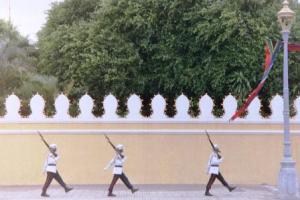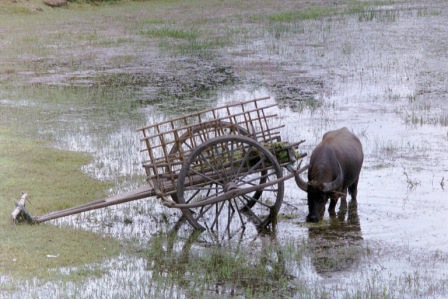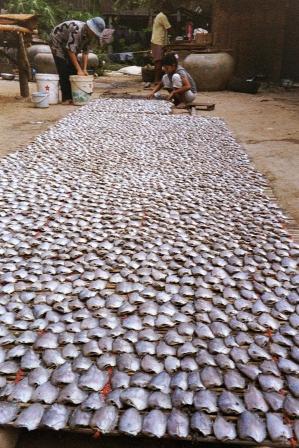
Opposite the infamous Toul Sleng prison, amid the dust, heat and noise of Phnom Penh, I found an oasis of green and peace. The Bodhi Tree Guesthouse and Café have welcomed people for meals since 1998 and for the past three years (written early 2000’s) have also had guest accommodation. The ten rooms are individually decorated with traditional Cambodian materials: all are extremely tasteful and most have an en-suite.
I know the food is great, not only because I tried it, but also because some 70% of their customers are locals who eat there.
The main idea of the Bodhi Tree, as well as being commercially viable, was to give a comfortable working space for young Cambodians who find themselves in challenging circumstances.
I talked with a young man who has worked there for two years.
‘I could find another job with more money but it would not be good like here’ he says ‘I like to stay here. Everyone is friendly and all are equal. I have learnt so much. Before I worked at my Auntie’s shop and could speak some English but I did not understand anyone talking about it. The accent was too hard – now I can talk to many people.’ He continues ‘I want to study management. My boss wants me to help others improve too. We only have people here who have a good attitude.’
Another young man tells me he has worked there for five months and that it was ‘ . . . a good place to work. I get two meals a day and it is a nice place to be. People are kind to me and I am learning many things. I stay in a house with some of the others who work here’ He also told me the restaurant was named after the tree in the story of how Buddhism started. (See sidebar)
The cook, who has cooked for three years, produces wonderful meals. She had been a cleaner at the Bodhi Tree before learning to cook and now her menu and skills could be used at any international restaurant she chose to work at. Along with the Asian and continental breakfasts from the kitchen, these became my favourites during my stay:
- Slow roasted honey and cinnamon Asian pears – topped with fresh blue cheese and walnut – served with balsamic vinegar.
- Red bean and steamed spinach salad with black pepper grilled bread with grated Parmesan and summer vinaigrette.
- Spanish potato omelette served with tomato, olives, and mint salad and garlic bread.
After a week of travelling on the back of a truck in the remote north-east of the country, being served these, while sitting on cane furniture, leaning against silk cushions, under a Bougainvillea tree in an outdoor room, and with a Buddha gazing serenely on the scene, was heavenly.
Surrounded by the delightful artwork, birds of paradise, orchids, lotus buds, and other floral arrangements or plants it was hard to imagine the horrors that had occurred right across the road in the prison S 21. (See sidebar 2 below)
Note: I wrote this many years ago and have just refound it!






Sidebar 1. (As told to me by one of the young workers at Bodhi Tree )During the 16th century, in what we now call Nepal, Prince Siddhartha Gautama became curious about what life was like outside his comfortable court existence. When he saw people suffering it caused him great pain and he decided to alleviate their suffering.
Giving up his comfortable life, and his wife and child, he set out to study various religions for the answers.
After some time he adopted a life of self denial and fasting until, on the verge of death, he realised that this was not the way to end suffering: in fact he was perpetuating it.
During this time he was meditating under a Bodhi tree and this was where he received the revelations which led to his enlightenment. These were on three successive nights: on the first night he saw his former lives pass before him; on the second he came to understand the cycle of life death and rebirth, and on the third night the four holy truths of suffering.
Despite receiving enlightenment he chose to remain on earth and help others.
Sidebar 2
Toul Sleng (known in the Pol Pot years as S-21 or Security Office 21) is now The Museum of Genocidal Crimes. This was Angkor’s’ primary security institution: designed for the interrogation and extermination of anti Angkor elements. Originally a high school (Ponhea Yat) and built in 1962 it was enclosed with corrugated iron and electrified barbed wire during the Khmer rouge regime. Prisoners came from all over the country, all walks of life and included different nationalities including British, American Australian and new Zealand.
Over 12, 000 people were killed at S-21. While in the cells prisoners were shackled to iron bars and on arrival had been photographed and details of their life recorded.
The museum is not only a reminder of Cambodia’s very recent history, but also serves as a warning about how badly very ordinary human beings can treat each other.

Absolutely beautiful photos. Thank you for sharing!
LikeLike
Thanks Yazzi
LikeLiked by 1 person